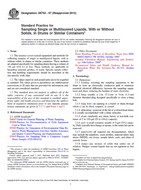Potřebujeme váš souhlas k využití jednotlivých dat, aby se vám mimo jiné mohly ukazovat informace týkající se vašich zájmů. Souhlas udělíte kliknutím na tlačítko „OK“.
ASTM D5571-94(2010)
Standard Test Method for Environmental Stress Crack Resistance (ESCR) of Plastic Tighthead Drums Not Exceeding 60 Gal (227 L) in Rated Capacity
Automaticky přeložený název:
Standardní zkušební metoda pro zatížení životního prostředí Odolnost proti vzniku trhlin (ESCR) Plastové Tighthead bubny nepřesahující 60 Gal (227 l) Jmenovitý výkon
NORMA vydána dne 1.4.2010
Informace o normě:
Označení normy: ASTM D5571-94(2010)
Poznámka: NEPLATNÁ
Datum vydání normy: 1.4.2010
Kód zboží: NS-31710
Počet stran: 4
Přibližná hmotnost: 12 g (0.03 liber)
Země: Americká technická norma
Kategorie: Technické normy ASTM
Kategorie - podobné normy:
Anotace textu normy ASTM D5571-94(2010) :
Keywords:
drum, environmental stress crack, internal pressure, plastic, stacking, stress crack, tighthead, Stress--plastics, Stress cracking tests, Tighthead drum, Drums, Environmental stress crack resistance (ESCR), Internal pressure/testing, Plastic shipping materials/applications, Pressure testing--packaging/containers, Shipping containers/materials/applications, Stacking test, Stress--environmental effects, ICS Number Code 55.140 (Barrels. Drums. Canisters)
Doplňující informace
| Significance and Use | ||||||
|
These procedures provide an indication of the environmental stress-crack resistance of plastic tighthead drums. This test method may be used for determining the applicability of various plastic resins, mold designs, processing techniques and parameters for plastic tighthead drums. Environmental stress cracking is indicative of what results when a container is exposed to chemical agents such as soaps, organics, bleaches, or any surface active solutions while under conditions of stress. Environmental stress cracking is a mechanism of chemical attack that is highly dependent upon the test reagent, resin, drum manufacturing or processing history, exposure temperature, and applied stress. The combination of these factors may result in eventual stress crack failure. Both procedures minimize the potential for test variability by providing the user with rigidly defined test conditions. This test method may be used as design qualification and auditing tools for plastic tighthead drums. This test method is not meant to provide a quantitative value of measurement (that is, number of days to failure). It is intended only as a pass/fail procedure in accordance with user's specifications, or as agreed upon between the user and supplier. It is not intended as a predictor or indicator of field performance regarding time to failure. |
||||||
| 1. Scope | ||||||
|
1.1 This test method provides an indication of the environmental stress crack resistance of plastic tighthead drums as a summation of the effects of container design, resin, manufacturing conditions, field performance, and other factors. 1.2 This test method may be used to evaluate a plastic drum's resistance to failure by cracking when in the presence of chemical and physical stresses. 1.3 Two procedures are provided as follows: 1.3.1 Procedure A—Internal pressure stress crack resistance method to nonyl phenoxypoly (ethyleneoxy) ethanol solution, a stress cracking reagent. The internal pressure is controlled at a constant elevated pressure and temperature. 1.3.2 Procedure B—Top-load stress crack resistance method to nonyl phenoxypoly ethanol, a stress cracking reagent. The compressive top load is controlled at a constant weight while maintaining an elevated temperature. 1.4 Although these procedures are not designed to test the ability of the closure or closure gasket material to retain the test reagent, the inclusion of closure failure as a container failure mode is optional. However, leakage through a closure may affect the internal pressure that could affect the test results. 1.5 This test method does not attempt to address all factors that could lead to stress cracking of plastic drums. The user of this standard may use other test parameters, such as top loads, chemical reagents, etc., as agreed upon between the user and supplier in the event of a drum qualification or purchase agreement. 1.6 The values stated in inch-pound units are to be regarded as the standard. The SI units given in parentheses are for information only. 1.7 This standard does not purport to address all of the safety concerns, if any, associated with its use. It is the responsibility of the user of this standard to establish appropriate safety and health practices and determine the applicability of regulatory limitations prior to use. Specific warning statements are given in 6.2. |
||||||
| 2. Referenced Documents | ||||||
|
Podobné normy:
Historická
1.4.2013
Historická
1.3.2012
Historická
1.6.2012
Historická
1.6.2006
Historická
1.7.2008
Historická
1.7.2008
Doporučujeme:
Aktualizace technických norem
Chcete mít jistotu, že používáte pouze platné technické normy?
Nabízíme Vám řešení, které Vám zajistí měsíční přehled o aktuálnosti norem, které používáte.
Chcete vědět více informací? Podívejte se na tuto stránku.



 ASTM D5743-97(2013)..
ASTM D5743-97(2013).. ASTM F2874-12
ASTM F2874-12 ASTM F670-02(2012)..
ASTM F670-02(2012).. ASTM F839-83(2006)..
ASTM F839-83(2006).. ASTM F852-08
ASTM F852-08 ASTM F976-08
ASTM F976-08
 Cookies
Cookies
